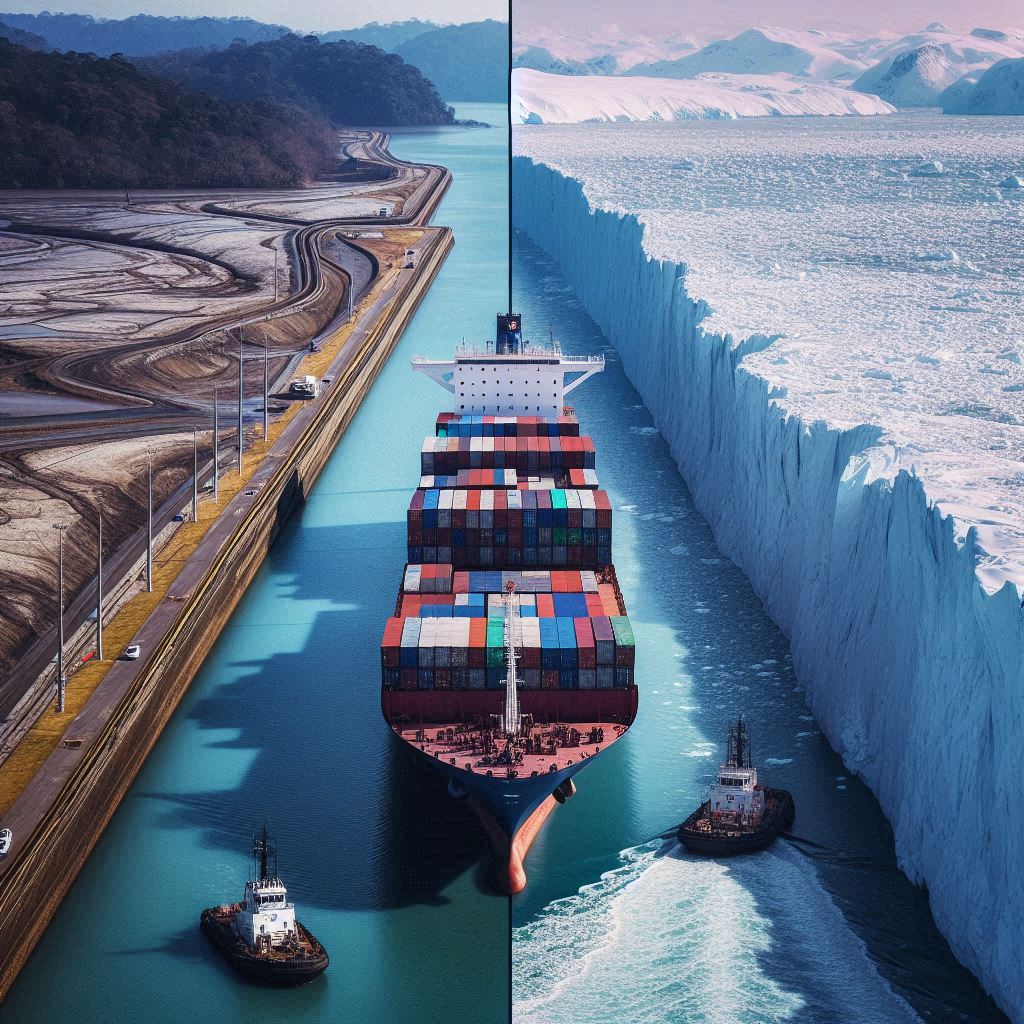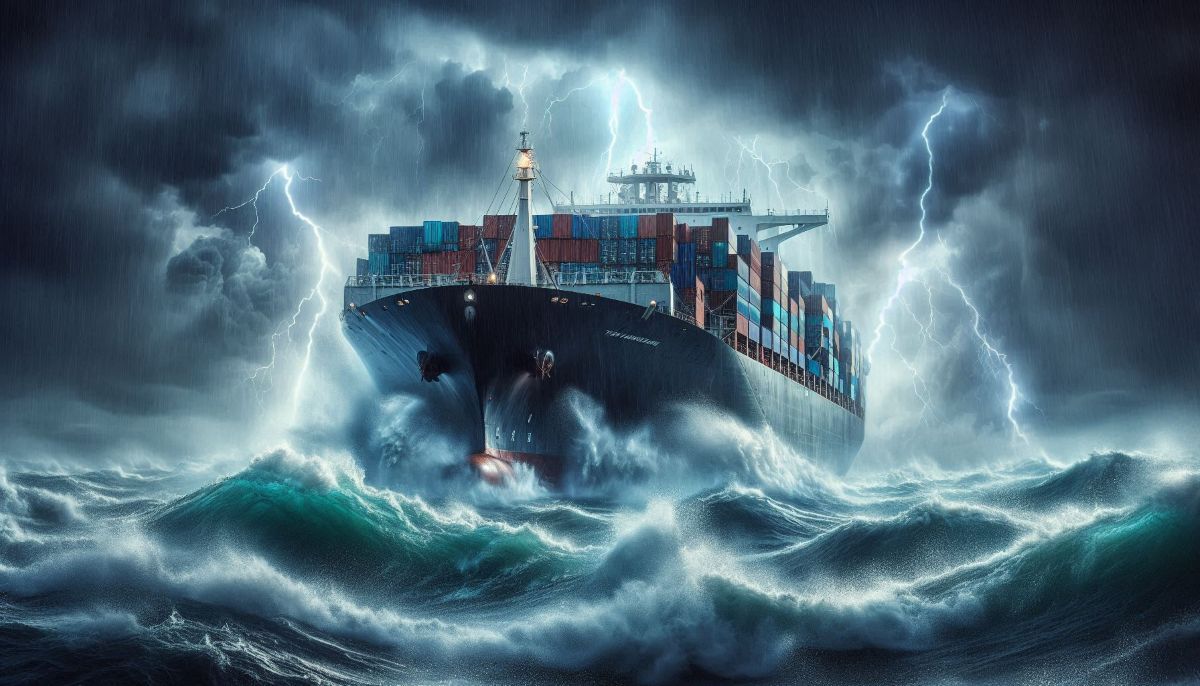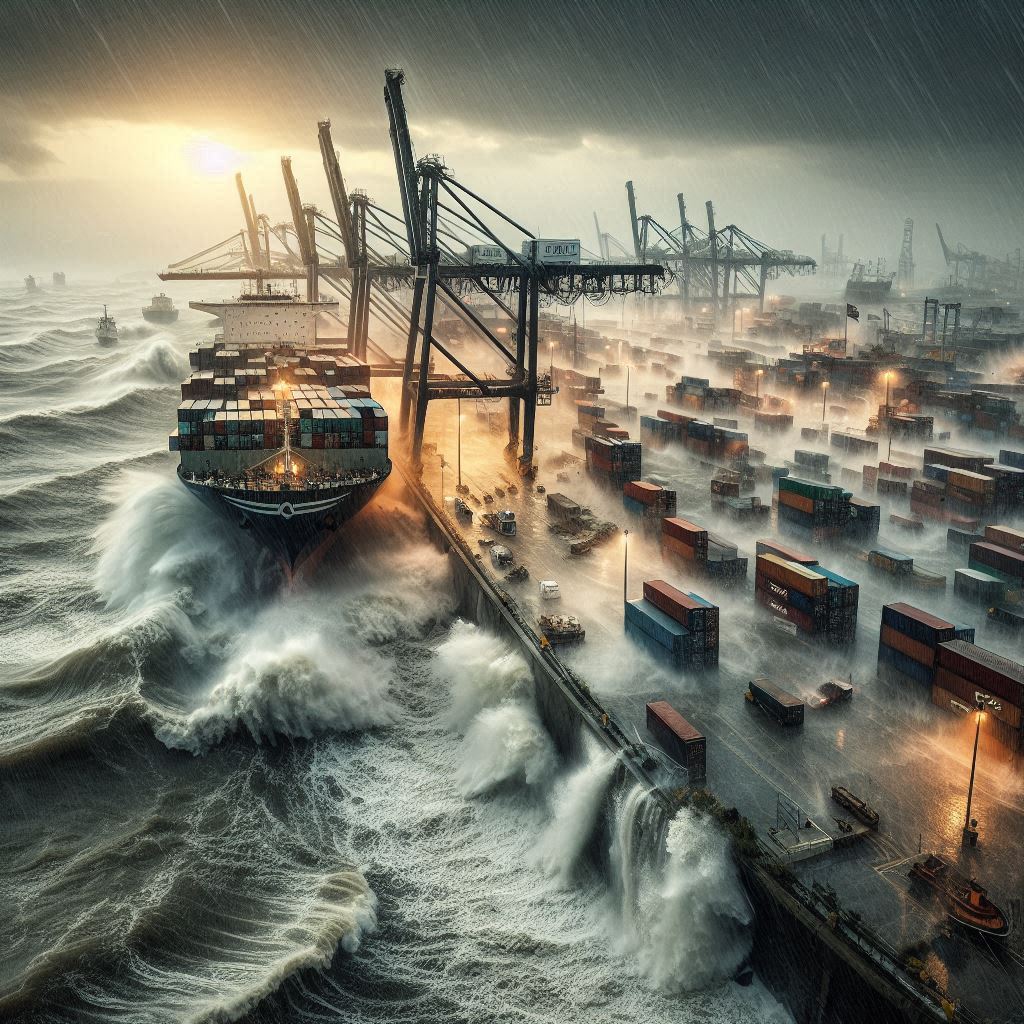
Watch short for this article (5 slides)
Shifting Tides, Shifting Trade: How Climate Change is Reshaping Global Shipping Routes
Global trade relies heavily on the predictable flow of goods across our oceans, a complex dance dependent on established shipping lanes and critical maritime chokepoints. However, the accelerating impacts of climate change are introducing unprecedented volatility into this system. From drought-stricken canals limiting passage to melting Arctic ice opening potentially hazardous new shortcuts, the physical realities of a warming planet are forcing a rapid and challenging adaptation within the maritime industry. These disruptions ripple outwards, affecting supply chains, economies, and consumers worldwide. This article delves into the specific ways climate change is impacting key shipping routes, the adaptations underway, and the profound implications for global commerce.

Chokepoints Under Pressure: Canals Feel the Heat (and Lack of Water)
Maritime chokepoints – narrow waterways connecting larger bodies of water – are vital arteries for global trade. Climate change is exposing their vulnerabilities in stark ways.
The Panama Canal: A Freshwater Crisis
- The Mechanism: Unlike sea-level canals, the Panama Canal uses a system of locks that rely on enormous amounts of freshwater to lift and lower ships between the Atlantic and Pacific Oceans. This freshwater is primarily supplied by Gatun Lake and Alajuela Lake, which are fed by regional rainfall.
- Climate Impact (Drought): Changes in precipitation patterns, including more intense but potentially less frequent rainfall and prolonged droughts (linked to phenomena like El Niño, which may be amplified by climate change), significantly reduce water levels in these crucial lakes.
- Operational Consequences: When lake levels drop, the Panama Canal Authority (ACP) must implement restrictions to conserve water:
- Draft Restrictions: Limiting the maximum depth a vessel can sit in the water (its draft). This forces larger ships (Neopanamax vessels) to carry less cargo per transit to ride higher, reducing efficiency and increasing per-unit shipping costs. For example, draft limits might be reduced from a typical 50 feet down to 44 feet or lower during severe droughts.
- Transit Reductions: Limiting the total number of vessels allowed to pass through the canal each day (e.g., reducing slots from ~36-38 down to potentially 24 or fewer). This creates significant backlogs, delays, and competition for transit slots, driving up booking fees.
- Economic Impacts: Delays and weight restrictions force shippers to seek longer, more expensive alternatives, such as sailing around South America (Cape Horn) or Africa (Cape of Good Hope), or using routes through the Suez Canal, increasing fuel consumption, transit times, and costs passed onto consumers.
- Adaptation Efforts: The ACP is investing in water-saving basins for its Neopanamax locks (which recycle water) and exploring long-term solutions like new reservoirs, though these face significant environmental and financial hurdles. (Panama Canal Authority - Water Information)
The Suez Canal: Indirect Impacts and Existing Vulnerabilities
- Importance: Connects the Mediterranean Sea and the Red Sea, handling a significant portion of global trade, especially between Asia and Europe.
- Climate Impact (Less Direct): While less directly impacted by drought than Panama, the Suez region faces potential climate challenges like extreme heat affecting operations and sea-level rise potentially impacting canal infrastructure over the long term. However, its primary vulnerabilities often stem from geopolitical instability and the sheer volume of traffic leading to congestion (highlighted by the Ever Given blockage in 2021). Climate-related disruptions elsewhere (like Panama) can increase pressure and congestion on the Suez route as shippers divert traffic.
The Arctic Opening: Opportunity Fraught with Peril

One of the most dramatic consequences of climate change is the rapid warming of the Arctic, leading to significant reductions in summer sea ice extent and thickness. This is tentatively opening up potential new shipping routes.
The Northern Sea Route (NSR)
- The Route: Runs along the Siberian coast within Russia's Exclusive Economic Zone (EEZ), connecting the Atlantic and Pacific Oceans via Arctic waters.
- Potential Advantage: Offers a significantly shorter distance for voyages between Northern Europe and East Asia compared to the Suez Canal route – potentially cutting transit time by **10-15 days (around 40% shorter distance)**.
- Climate Enabler: Reduced summer sea ice makes passage feasible for a longer window each year, although conditions remain highly variable.
- Significant Challenges and Risks:
- Ice Variability: While decreasing overall, Arctic sea ice conditions remain unpredictable. Multi-year ice (thicker, harder ice) can still drift into shipping lanes unexpectedly, requiring icebreaker escorts (often controlled by Russia and costly) or specialized ice-class vessels. The navigable season is still limited.
- Lack of Infrastructure: The route is sparsely populated with limited deep-water ports, inadequate navigational aids (charts, weather forecasting), and virtually non-existent search and rescue (SAR) capabilities along vast stretches.
- Environmental Sensitivity: The Arctic ecosystem is fragile. Increased shipping raises risks of oil spills (extremely difficult to clean up in icy conditions), introduction of invasive species via ballast water, underwater noise pollution impacting marine mammals, and deposition of black carbon (soot) from ship exhaust onto ice, accelerating melting. (Arctic Council - Shipping Information)
- Geopolitical Factors: Russia heavily regulates and aims to control traffic along the NSR, imposing fees and requirements, adding a layer of political complexity.
- Current Viability: While transit numbers are increasing, the NSR is currently used primarily for destination shipping (e.g., transporting Russian LNG) rather than widespread trans-Arctic voyages, due to the substantial risks and costs. Its future as a reliable global alternative remains uncertain and controversial.
Beyond Chokepoints: Broader Climate Impacts on Maritime Operations

Climate change affects shipping globally, not just at specific canals or routes:
- More Frequent and Intense Severe Weather: Climate change fuels more powerful hurricanes/typhoons, intense storms, and potentially altered wave climates ("rogue waves"). This leads to:
- Increased risk of vessel damage or loss.
- Port closures and operational disruptions.
- Longer, costlier route deviations to avoid storms.
- Safety risks for crews.
- Container losses overboard in heavy seas.
- Sea-Level Rise Impacts on Ports: Rising sea levels threaten low-lying coastal port infrastructure worldwide through:
- Permanent inundation of docks, terminals, and storage areas.
- Increased frequency of flooding during high tides and storm surges.
- Damage to infrastructure foundations and increased corrosion.
- Changes in sedimentation patterns requiring more frequent dredging of channels.
- Ports like Rotterdam, Shanghai, Miami, and many others require significant investment in adaptation measures (raising infrastructure, building barriers).
- Changes in Ocean Currents and Winds: Climate change can alter wind patterns and ocean currents, potentially affecting optimal shipping routes and fuel consumption.
Industry Under Pressure: Adaptation and Mitigation Efforts
The maritime industry faces immense pressure to adapt to these physical changes while simultaneously decarbonizing its operations:
- Regulatory Drivers: The International Maritime Organization (IMO), the UN body regulating shipping, has set ambitious goals to reduce greenhouse gas emissions from ships (aiming for net-zero by or around 2050). Regulations like the Energy Efficiency Existing Ship Index (EEXI) and the Carbon Intensity Indicator (CII) mandate improvements in ship efficiency and emissions performance.
- Technological Innovation:
- Alternative Fuels: Significant investment and research into low- and zero-carbon fuels like Liquefied Natural Gas (LNG - as a transitional fuel), methanol, ammonia, hydrogen, and biofuels. Each presents challenges regarding production, storage, safety, and infrastructure.
- Energy Efficiency Technologies: Development and deployment of technologies like wind-assisted propulsion (rotor sails, rigid sails), air lubrication systems (reducing hull friction), advanced hull coatings, waste heat recovery systems, and bulbous bow optimization.
- Operational Adjustments:
- Route Optimization Software: Using advanced weather forecasting and oceanographic data to plan the most fuel-efficient routes, avoiding adverse conditions.
- Slow Steaming: Deliberately reducing vessel speeds to significantly cut fuel consumption and emissions (though this can impact delivery schedules).
- Port Call Optimization: Improving coordination between ships, ports, and terminals to reduce waiting times and idling emissions.
"The dual challenge for shipping is adapting its routes and infrastructure to the physical impacts of climate change while simultaneously undertaking a massive technological shift to decarbonize its own operations. Both are essential for the future of global trade." - Maritime Industry Analyst Perspective (Synthesized).
Economic and Consumer Ripple Effects
Disruptions to maritime trade have significant downstream consequences:
- Increased Costs: Rerouting, delays, higher fuel consumption due to inefficiencies or transitions to expensive alternative fuels, and investments in adaptation all translate into higher shipping costs.
- Supply Chain Volatility: Climate-related disruptions add another layer of uncertainty to already complex global supply chains, potentially leading to product shortages and delivery delays for consumers.
- Inflationary Pressures: Higher shipping costs are often passed on through the supply chain, contributing to inflation for imported goods.
- Shifts in Trade Patterns: Persistent disruptions could incentivize businesses to diversify supply chains, explore nearshoring or reshoring options, or favor more resilient (though potentially more expensive) transportation modes where feasible.
Conclusion: Navigating Toward Resilient and Sustainable Maritime Trade
Climate change is no longer a distant threat to global shipping; it is an active force reshaping maritime routes, challenging critical infrastructure, and driving operational change. The vulnerability of key chokepoints like the Panama Canal, the complex potential of Arctic routes, and the pervasive impacts of severe weather and sea-level rise demand immediate attention. While the shipping industry is beginning to invest in adaptation and decarbonization, the scale of the challenge requires unprecedented global cooperation. Reducing greenhouse gas emissions remains the fundamental solution to limit the long-term severity of these disruptions. Simultaneously, investing in climate-resilient infrastructure, improving forecasting and monitoring, and fostering adaptive management strategies are crucial to ensuring the continued flow of global trade in a rapidly changing world.